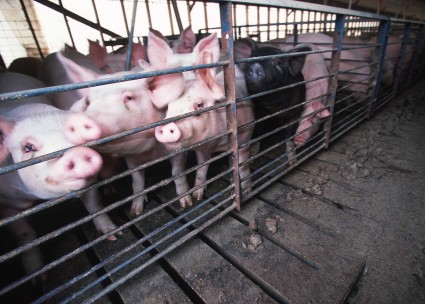
Hogs in CAFOs like this one are routinely fed antibiotics to prevent disease and promote growth.
Updated June 30
The FDA took a significant step yesterday toward restricting the routine feeding of subtherapeutic (medically unnecessary) doses of antibiotics to livestock. As Grist has detailed in previous coverage, this practice — which by some estimates consumes nearly 70% of all antibiotics administered in the U.S. — has been linked to the rise of antibiotic resistance, both in common pathogens such as salmonella and in previously rare ones such as MRSA. (For more on MRSA listen to Grist’s Tom Philpott speak with Superbug author Marilyn McKenna.)
A recent report from the American Society of Microbiologists on the growing threat of antibiotic resistance urged an end to industrial agriculture’s indiscriminate and virtually unregulated use of antibiotics as “growth promotants” in order to maintain the drugs’ effectiveness for people. Animals in concentrated animal feeding operations, or CAFOs, are routinely given antibiotics to help them tolerate the stressful, crowded conditions they are raised in; for an unknown reason, the drugs generally help them grow bigger, faster. Industry stands by the practice and downplays any risks it may represent to public health.
With legislation to restrict the use of antibiotics in livestock bottled up in House and Senate committees, both sides have looked to the FDA to take the lead. FDA Administrator Dr. Margeret Hamburg, as well as her deputy Joshua Sharfstein, had indicated their intention to act on the issue.
And now they have, in the form of what’s called “draft guidance.” Neither a full regulatory rule nor a law, it’s meant to establish procedures the FDA would like an affected industry to follow — and is subject to an open comment period before it becomes official guidance.
In the case of administering antibiotics to farm animals, the most important statement in this new document is that the “FDA thinks that using medically important antimicrobial drugs to increase production in food-producing animals is not a judicious use.”
While this may sound like so much bureaucratese, it represents a strong statement by the FDA and suggests further action is forthcoming. In addition, the agency declared itself to be particularly concerned about antibiotics that:
- Were approved before 2003
- Are used in food-producing animals to increase production;
- Are available over-the-counter (OTC), and therefore, can be given without a veterinarian’s involvement; and
- Are given continuously through the feed or water to entire herds or flocks of animals.
This draft, though clearly preliminary and subject to industry feedback, also gives Congress a reason to move forward on legal restrictions knowing that a scientific consensus is forming — though in reality it’s unlikely a law could be passed much before November, if at all.
The question remains just how hard Big Meat will fight this guidance. The FDA wants to bend over backwards to limit problems for livestock producers by phasing in restrictions and taking their concerns into account. But will groups like the Pork Board — which denied the very existence of the problem to CBS News anchor Katie Couric in her blockbuster report on the subject — take the hand the FDA has offered? Or will they bite it?
Or will CAFO operators simply seek to bypass any regulation altogether, by claiming that routine doses of antibiotics are medically necessary to prevent disease in close quarters?
[Update] I asked microbiologist Margaret Mellon, director of the Union of Concerned Scientists’ Food and Agriculture Program and a specialist in the area of antibiotics, her thoughts on the FDA guidance. In short, she is not impressed. There isn’t even enough within the guidance, according to Mellon, to determine what kind of loopholes might exist. As she put it, via email:
I hoped by this time the Agency would have developed an action plan or at least a menu of potential ACTIONS to offer to the public. The fact that it is still at the “principle” stage suggests some big obstacle to action… most probably the political opposition of the animal agriculture industry. One way of looking at the statement is that FDA is giving the industry a chance to step up and volunteer to do the right thing, with the implicit threat that if it doesn’t FDA will use its regulatory tools. But so far, it’s saber-rattling at best.
We know that subtherapeutic use of antibiotics in livestock is unnecessary. The Danes have, somewhat famously, proved it by banning the practice and significantly reduced the threat of antibiotic resistance with no long-term effects on livestock health or productivity. The American Society of Microbiologists knows it. The FDA does, too. Even over a hundred House members and 17 senators (that being the number of cosponsors attached to the pending legislation) know it. With any luck, the industry will finally get the message.




